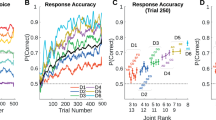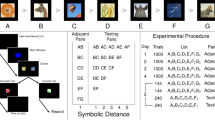Abstract
Organisms are often faced with sets of stimuli bearing specifiable relationships to each other. Experimental data suggest that even animals not suspected of being particularly rational can solve problems involving consistent linear relationships. We examine the information processing required to cope with these and related stimulus structures from a theoretical point of view. We show that both a parallel processing neural network model and a serially processing Turing machine model require minimal complexities to process linear hierarchical structures. When dealing with other relational stimulus structures, the models need differing, greater minimal complexities. Siemann and Delius (1994) report experimental results indicating that both pigeons and humans appear to operate according to the parallel, neural network model we propose here. Further experiments likely to be diagnostic are proposed.
Similar content being viewed by others
References
Davis RL (1954) Structures of dominance relations. Bull Math Biophys 16:131–140
Dayhoff J (1990) Neural network architectures. Van Nostrand Reinhold, New York
Fersen L von, Wynne C, Staddon JER, Delius JD (1990) Deductive reasoning in pigeons. Naturwissenschaften 77:548–549
Fersen L von, Wynne C, Staddon JER, Delius JD (1991) Transitive inference formation in pigeons. J Exp Psychol [Anim Behav] 17:334–341
Gerber S (1979) Automaten. In: Grosche G, Ziegler V (eds) Taschenbuch der Mathematik Teubner, Leipzig
Harary F (1969) Graph theory. Addison-Wesley, Reading, Mass.; German translation (1974) Graphentheorie. Oldenbourg, Munich
Henley N, Horsfall R, De Soto C (1969) Goodness of figure and social structure. Phychol Rev 76:194–204
Rumelhart DE, McClelland JL (1986) Parallel distributed processing. MIT Press, Cambridge, Mass
Siemann M, Delius JD (1994) Processing of hierarchical stimulus structures has advantages in humans and pigeons. Biol Cybern 71:531–536
Author information
Authors and Affiliations
Rights and permissions
About this article
Cite this article
Carmesin, H.O., Schwegler, H. Parallel versus sequential processing of relational stimulus structures. Biol. Cybern. 71, 523–529 (1994). https://doi.org/10.1007/BF00198470
Received:
Accepted:
Issue Date:
DOI: https://doi.org/10.1007/BF00198470




